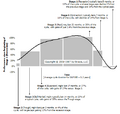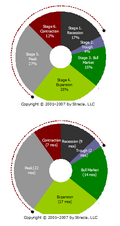Business Cycle: Typical Cyclical Profile
The exhibit below depicts the actual performance of the S&P 500 throughout the last nine economic cycles, and describes average metrics that characterize each of the six stages of a cycle, such as performance and duration.

(Click to enlarge)(For the more mathematically inclined: The heavy black line in the chart is a six-order polynomial curve that best describes the average performance of the large-cap index as it rotates through the six stages of the cycle. We realize that a six-order polynomial is quite a high degree—and thus, one might think, risks over-specifying the “best fit.” But the specification is for graphical purposes only—we do not use this polynomial function to forecast expected index performance, for example, or for any forecasting purposes. Note also that the chart appears to show that the S&P 500 finishes the average cycle at a lower level than it started—but we know this is impossible as, over the long-term, the market has generally been upward-trending. A cycle’s final stage is Contraction, not Recession, so the exhibit does in fact show the average, upward-trending performance that has characterized the S&P 500 over the last nine cycles.)

(Click to enlarge)
At left, the uppermost pie chart depicts the average cycle as having lasted 72 months (or 6.0 years) for large-cap equities. It shows that on average, the Bull Market stage has lasted 14 months over the course of the last eight complete cycles——or 19% of 72 months (the average cycle duration). The figure at bottom, however, indicates that the Bull Market stage represented 15% of total cycle (not 19%).
This discrepancy is accurate, as the uppermost chart measures the absolute number of months of each cyclical stage since July, 1950; while the exhibit at bottom represents the portion of each cycle spent in each stage. Naturally, since each cycle and stage is of different duration, the amount of time spent in each stage will differ from cycle to cycle.
« Previous: Typical Cyclical Profile | Next: Compare to Buy-and-Hold »
Your suggestions for improving this site are greatly appreciated. (To report an error on this page, please copy the URL before visiting the suggestion box.)



